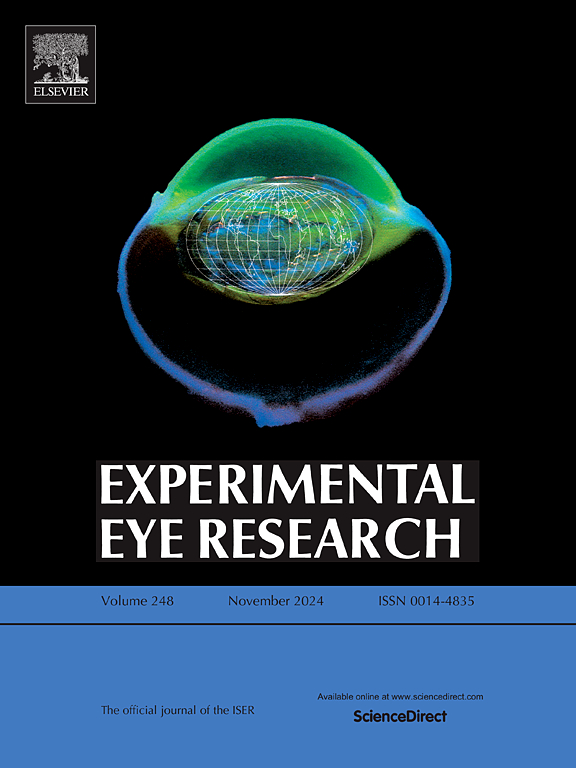Melatonin ameliorates retinal neurovascular degeneration in Rd1 mice by inhibiting oxidativestress
IF 3
2区 医学
Q1 OPHTHALMOLOGY
引用次数: 0
Abstract
Oxidative stress has been involved in the occurrence of retinal photoreceptor degeneration and retinal vascular dysfunctions. This study investigated the effects of melatonin (MLT) on neurovascular changes in rd1 mice, evaluating its therapeutic potential as an antioxidant for retinal degeneration. MLT was administered to rd1 mice at postnatal day 7 (P7), and retinal vascular alterations were assessed using retina flatmounts, while neural and functional changes were evaluated through frozen sections and electroretinography at P14. In vitro, human retinal microvascular endothelial cells (HRMECs) were treated with MLT to counteract oxidative stress induced by H2O2. Analyses included assessments of cell function, apoptosis, oxidative stress, and inflammatory markers in both in vivo and in vitro models. The results demonstrated that MLT significantly improved retinal vascular densities in the deep and superficial layers at P14 and P21, though not fully restoring them to wild-type levels. Additionally, MLT exerted protective effects against photoreceptor degeneration, oxidative stress, and inflammation, partially preserving retinal function. In vitro, MLT alleviated functional abnormalities and reduced cell death in HRMECs by decreasing reactive oxygen species levels. These findings suggest that MLT holds promise as a therapeutic approach for retinal degeneration by mitigating oxidative stress, thereby protecting photoreceptors and retinal vasculature. This underscores the importance of vascular preservation in developing therapeutic strategies for retinal degenerative diseases.
褪黑激素通过抑制氧化应激改善 Rd1 小鼠视网膜神经血管变性的情况
氧化应激参与视网膜光感受器变性和视网膜血管功能障碍的发生。本研究探讨褪黑素(MLT)对rd1小鼠神经血管变化的影响,评估其作为抗氧化剂治疗视网膜变性的潜力。在rd1小鼠出生后第7天(P7)给予MLT,并使用视网膜平板支架评估视网膜血管变化,而在P14时通过冷冻切片和视网膜电图评估神经和功能变化。在体外,用MLT处理人视网膜微血管内皮细胞(HRMECs),以对抗H2O2诱导的氧化应激。分析包括在体内和体外模型中评估细胞功能、凋亡、氧化应激和炎症标志物。结果表明,MLT显著提高了P14和P21视网膜深层和浅层血管密度,但不能完全恢复到野生型水平。此外,MLT对光感受器变性、氧化应激和炎症具有保护作用,部分保留视网膜功能。在体外,MLT通过降低活性氧水平减轻了hrmec的功能异常和细胞死亡。这些发现表明,MLT有望作为一种治疗视网膜变性的方法,通过减轻氧化应激,从而保护光感受器和视网膜血管。这强调了血管保存在发展视网膜退行性疾病治疗策略中的重要性。
本文章由计算机程序翻译,如有差异,请以英文原文为准。
求助全文
约1分钟内获得全文
求助全文
来源期刊

Experimental eye research
医学-眼科学
CiteScore
6.80
自引率
5.90%
发文量
323
审稿时长
66 days
期刊介绍:
The primary goal of Experimental Eye Research is to publish original research papers on all aspects of experimental biology of the eye and ocular tissues that seek to define the mechanisms of normal function and/or disease. Studies of ocular tissues that encompass the disciplines of cell biology, developmental biology, genetics, molecular biology, physiology, biochemistry, biophysics, immunology or microbiology are most welcomed. Manuscripts that are purely clinical or in a surgical area of ophthalmology are not appropriate for submission to Experimental Eye Research and if received will be returned without review.
 求助内容:
求助内容: 应助结果提醒方式:
应助结果提醒方式:


